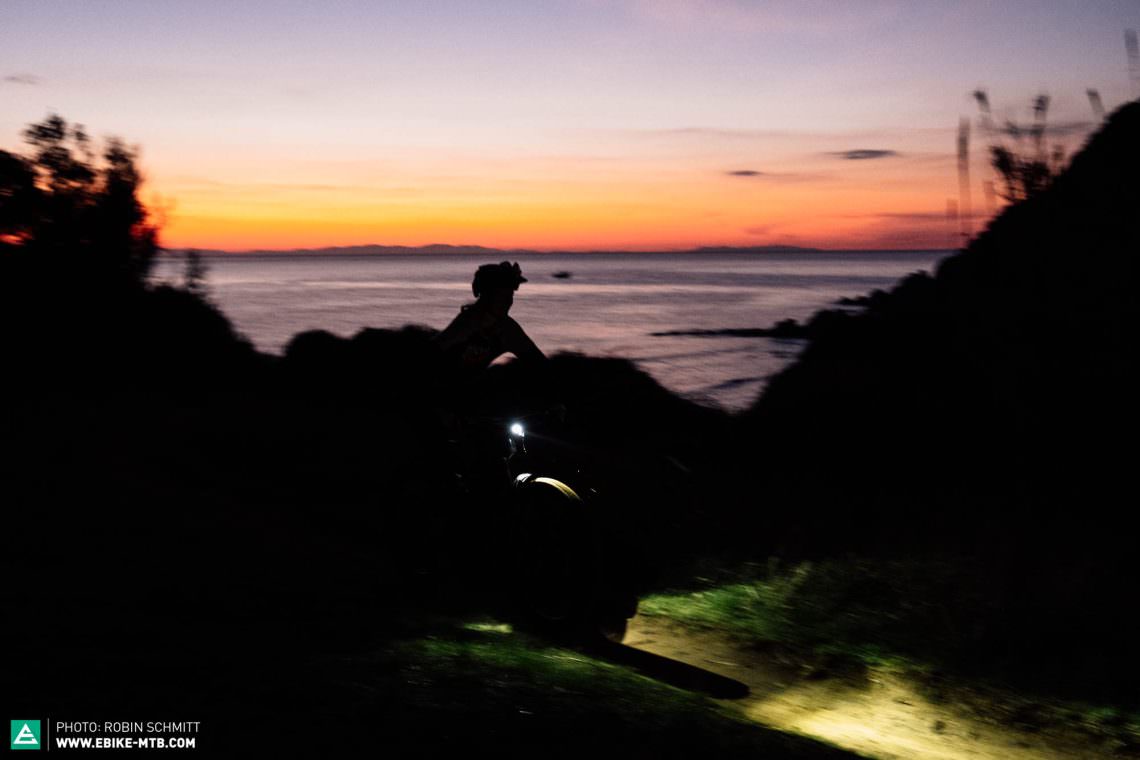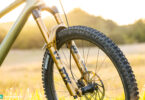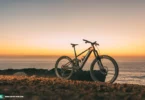After securing victory in our huge 2021 eMTB group test, the MERIDA eONE-SIXTY 10K is determined to defend its title for the second year running. In our 2022 eMTB group test, the titleholder enters the race unchanged. Was the eONE-SIXTY 10K able to assert itself against the competition in our 2022 group test or are there better all-rounders on the market?
For an overview of the test fleet head to the group test: The best eMTB of 2022 – 13 models in review

22.98 kg in size L | € 9,899 | Manufacturer’s website
In our huge 2021 eMTB group test, the MERIDA eONE-SIXTY 10K was able to assert itself against the competition as the most versatile eMTB of the year, delivering tremendous performance on the trail. Except for a fresh paint finish, the title defender enters our 2022 group test unchanged, sharing the same frame platform, Shimano EP8 motor system and 630 Wh battery as its predecessor. All cables and connections are routed inside the handlebar and run from the stem directly into the frame, leaving only the cables and hoses for the Shimano XTR brakes and drivetrain. These enter the frame via the THERMO GATE in the head tube. Aesthetically, the alloy swingarm doesn’t match the elegant look of the carbon frame and the cables. This includes the cables, which are secured to the chainstays with basic zip ties. The Lezyne headlight on the handlebars is a unique feature in this test field. Thanks to the high 117 kg payload, trailer approval and kickstand, the eONE-SIXTY 10K is also suitable for everyday riding.



Flawless – The spec of the MERIDA eONE-SIXTY 10K
Don’t fix it if it ain’t broken! The spec of the 22.98 kg MERIDA remains unchanged from last year and leaves little to be desired. The suspension consists of a FOX 38 Factory GRIP2 fork and FOX X2 Factory shock, controlling 160/150 mm travel at the front and rear respectively. Shifting is taken care of by a high-end 12-speed Shimano XTR divertrain while Shimano XTR four-piston brakes with 200 mm ICE-TECH rotors front and rear do stopping duties. The high-end spec is rounded off by a 170 mm RockShox Reverb AXS dropper post, which is far superior to any other mechanical dropper in this test for ergonomics and speed of operation. MAXXIS tires with robust Doubledown casings are paired with a DT Swiss HXC 1250 carbon wheelset. With the 3C MaxxGrip rubber compound, the MAXXIS ASSEGAI front tire is one of the grippiest front tires in the entire test field. The Minion DHR II rear tire comes with the slightly harder and more durable MaxxTerra compound – what a great combo!

The rear suspension of the eONE-SIXTY 10K harmonises perfectly with the shock. While the stiff suspension provides plenty of support and reserves, it also generates plenty of traction. Moreover, all dials on the shock are easily accessible, making suspension setup quick and easy.

With its discreet-looking Lezyne headlight, high 117 kg payload, trailer approval and kickstand mount, the eONE-SIXTY 10K is ready for everyday use.

With its long 470 mm seat tube (size L), the Merida goes against modern geometry trends. Unfortunately, this restricts freedom of movement on the bike and makes it hard to choose the frame size based on your desired reach.

All cables run through the handlebars directly into the stem while the rear brake line and shifting cable are routed through the THERMOGATE in the head tube. This ensures a very tidy cockpit, which unfortunately stands in contrast with the messy cable management at the rear: there are definitely tidier solutions than those basic cable ties!
MERIDA eONE-SIXTY 10K
€ 9,899
Specifications
Motor Shimano EP8 85 Nm
Battery Shimano BT-E8036 630 (504 in XS) Wh
Display Shimano SC-EM800
Fork FOX 38 Factory GRIP2 160 mm
Rear Shock FOX X2 Factory 150 mm
Seatpost RockShox Reverb AXS 170 mm
Brakes Shimano XTR M9120 200/200 mm
Drivetrain Shimano XTR 1x12
Stem MERIDA Expert eTRII 40 mm
Handlebar MERIDA Expert eTR 780 mm
Wheelset DT Swiss HXC1250 SPLINE 29"/27.5"
Tires MAXXIS ASSEGAI / Aggressor DD 2.5"
Technical Data
Size XS S M L XL
Weight 22.98 kg
Perm. total weight 140 kg
Max. payload (rider/equipment) 117 kg
Trailer approval yes
Kickstand mount yes
Specific Features
Lezyne lights
Multi-tool underneath the saddle

For the wheels, MERIDA rely on MAXXIS tires with the robust Doubledown casing and DT Swiss HXC 1250 carbon wheelset. This combination allows you to run lower air pressures without having to worry about your expensive carbon rims too much. Top!

Shimano XTR four-piston brakes with 200 mm ICETECH rotors ensure reliable and powerful deceleration.

The MERIDA comes with a multi-tool hidden under the saddle and a removable rear light as standard.

Although the Lezyne headlight isn’t powerful enough for full-on night-riding, it allows you to throw in one last lap on your post-work ride.
The geometry of the MERIDA eONE-SIXTY 10K
The MERIDA combines a compact 460 mm reach (size L) and the highest front in the entire test field. At 470 mm in size L, the long seat tube doesn’t reflect current geometry trends, restricting freedom of movement on the bike and making it hard to choose the frame size based on your desired reach. In this regard, the competition has evolved massively over the past few years. The high front ensures a relaxed pedalling position. Given the pronounced kink in the seat tube, we recommend pushing the saddle all the way forward, especially if you have long legs. This will ensure a more efficient climbing position which is also comfortable on flat trails. With its stiff, sporty suspension and medium-sized battery, the MERIDA may not be the best option for long rides but is still more comfortable than the Specialized Levo or Yeti 160E T1.
| Size | XS | S | M | L | XL |
|---|---|---|---|---|---|
| Top tube | 563 mm | 584 mm | 606 mm | 629 mm | 652 mm |
| Seat tube | 405 mm | 420 mm | 440 mm | 470 mm | 500 mm |
| Head tube | 110 mm | 115 mm | 120 mm | 135 mm | 150 mm |
| Head angle | 65.5° | 65.5° | 65.5° | 65.5° | 65.5° |
| Seat angle | 76.5° | 76.5° | 76.5° | 76.5° | 76.5° |
| Chainstays | 440 mm | 440 mm | 440 mm | 440 mm | 440 mm |
| BB Drop | 18 mm | 18 mm | 18 mm | 18 mm | 18 mm |
| Wheelbase | 1,168 mm | 1,190 mm | 1,212 mm | 1,239 mm | 1,265 mm |
| Reach | 400 mm | 420 mm | 440 mm | 460 mm | 480 mm |
| Stack | 629 mm | 633 mm | 638 mm | 652 mm | 665 mm |

Jersey Mons Royale Tarn Freeride LS Wind Jersey | Shorts Mons Royale Momentum
Kneepad iXS FLOW EVO+ | Shoes Five Ten Freerider Pro | Socks Mons Royale
MERIDA’s eONE-SIXTY 10K is an all-rounder on the trail
On moderate climbs, the MERIDA winds its way up the trail with ease and encourages you to play with the terrain, rewarding your efforts with plenty of fun. On steep trails, the pronounced kink in the seat tube positions you far back over the rear wheel, requiring long-legged riders to actively weight the front wheel to keep it tracking. When negotiating steep and technical climbing sections, the eONE-SIXTY 10K makes it easy to ride out of the saddle, always generating good traction despite the shock remaining high in its travel.

Whether you’re cruising the flow, shredding the gnar or bombing down a bike park track, the MERIDA impresses with excellent all-round characteristics, regardless of your riding skills.



The MERIDA faces almost every challenge with composure and shines with its excellent all-round characteristics. As you can see, this made our tester Anna very happy.
Das MERIDA eONE SIXTY 10K im Downhill-Test
Drop the saddle, stand up and have a blast! With its accurate yet predictable handling, the agile MERIDA eONE SIXTY 10K conveys huge amounts of confidence, allowing you to negotiate any trail with ease. The weight is evenly distributed between the front and rear, making it easy to negotiate open corners at high speeds, even for beginners. The supportive suspension allows you to pop off ledges and generate speed on flowing trails. On steep technical trails and fast bikepark tracks, the MERIDA rewards an active riding style. Here, above all, it impresses with its excellent suspension, high front and grippy tires, enabling experienced riders to ride fast and implement spontaneous direction changes. Unfortunately, the long seat tube restricts freedom of movement. Although the MERIDA is still among the best-performing and most fun bikes in this test. However, the MERIDA can’t match the composure of the brand-new Yeti or the agility of the Orbea with its small battery.


Tuning tip: Riders with long legs should push the saddle forward

Riding Characteristics
7Agility
- sluggish
- playful
Stability
- nervous
- stable
Handling
- demanding
- balanced
Riding fun
- boring
- lively
Motor feeling
- digital
- natural
Motor power
- weak
- strong
Value for money
- poor
- top
Conclusion
If you’re looking for an eMTB all-rounder, the MERIDA eONE SIXTY 10K is still a great option. Although it’s great fun and still delivers impressive performance on the trail, it can’t keep up with the best eMTBs on the market anymore. Despite its versatile character, flawless spec and good-natured handling, the MERIDA wasn’t able to claim the Best in Test for the second year running.
Tops
- good all-rounder
- intuitive handling
- flawless spec
Flops
- restricted freedom of movement downhill
- cable management at the rear

You can find out more about at merida-bikes.com
The test field
For an overview of the test fleet head to the group test: The best eMTB of 2022 – 13 models in review
All bikes in test: FOCUS JAM² 7.0 (Click for review) | MERIDA eONE-SIXTY 10k | Norco Sight VLT C1 (Click for review) | Orbea Rise M-Team (Click for review) | Rocky Mountain Altitude Powerplay C70 (Click for review) | ROTWILD R.E375 PRO (Click for review) | SCOR 4060 Z ST XT (Click for review) | SCOTT Ransom eRIDE 910 (Click for review) | Specialized S-Works Turbo Levo (Click for review) | Specialized S-Works Turbo Kenevo SL (Click for review) | Trek Rail 9.9 XX1 AXS (Click for review) | Yeti 160E T1 (Click for review) | YT DECOY MX CORE 4 (Click for review)

Relaxed and comfortable riding on surfaced roads, both uphill and downhill.↩
Easy climbs up trails with few obstacles, wide turns and a moderate incline.↩
Active and playful descents on easy trails with few obstacles, wide turns and a moderate slope.↩
Single-track climbs on challenging terrain. Loose ground, steps, roots, tight corners and occasionally extreme inclines.↩
Singletrack descents on challenging terrain. Loose ground, steps, roots, tight corners and small jumps as well as some very steep descents.↩
High speed descents on sometimes very rough trails with large jumps and obstacles that you can’t roll over.↩
The rating used for riding characteristics refers to the bikes in the group test and the current state of development of eMTBs. The best bikes managed to blend supposedly opposite riding characteristics, feeling both lively and stable at the same time. The handling describes the balance of the bike on downhill sections. The information regarding motor-power refers to the ride-feeling in the overall context of the bike and not exclusively to the motor – that’s why the same motor can present different values.↩
Did you enjoy this article? If so, we would be stoked if you decide to support us with a monthly contribution. By becoming a supporter of E-MOUNTAINBIKE, you will help secure a sustainable future for high-quality cycling journalism. Click here to learn more.
Words: Photos: Robin Schmitt, Julian Lemme









